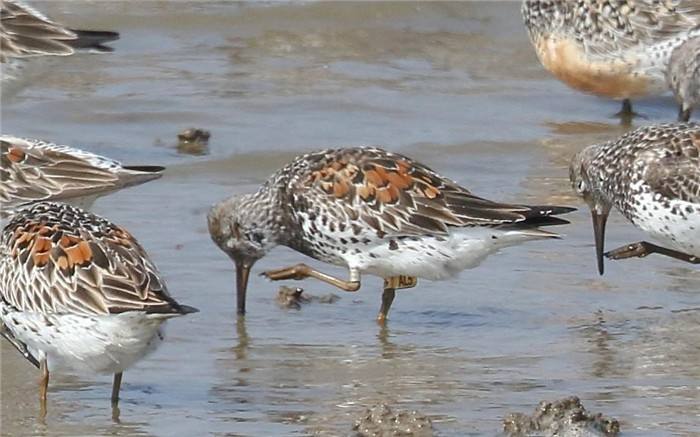Calidris tenuirostris
IUCN
LCBasic Information
Scientific classification
- name:Calidris tenuirostris
- Scientific Name:Calidris tenuirostris,Great Knot
- Outline:Wading birds
- Family:Charadriformes Sandpiper Calidris
Vital signs
- length:26-30cm
- Weight:135-207g
- lifetime:No textual research information is available
Feature
It is the largest of the sandpiper
Distribution and Habitat
Place of origin: Australia, Bangladesh, Brunei Darussalam, China, Guam, India, Indonesia, Iran (Islamic Republic of), Japan, Democratic People's Republic of Korea, Korea, Kuwait, Malaysia, Federated States of Micronesia, Myanmar, Northern Mariana Islands, Oman, Pakistan, Palau, Papua New Guinea, Philippines, Russian Federation (East Asia) Russia), Saudi Arabia, Singapore, Sri Lanka, Thailand, Timor-Leste, United Arab Emirates and Viet Nam.
Wandering: Bahrain, Denmark, Djibouti, Germany, Ireland, Israel, Mauritius, Morocco, Netherlands, New Caledonia, New Zealand, Norway, Qatar, Seychelles, Spain, United Kingdom, United States, and Yemen.
China: During the migration, it passed through Jilin, Liaoning, Hebei, Shandong, Jiangsu, Zhejiang, Fujian, Guangdong, Hainan Island, Hong Kong and Taiwan. Some wintered off the coast of Guangdong, Hainan Island and Taiwan in China.
It mainly inhabits coasts, estuarine sandbanks and nearby swamps, and is also found along open rivers and l
Appearance
Xia Yu head gray brown with dark brown longitudinal lines, brow lines white but not clear. Face and neck side, front neck white with fine black brown lines, through the eye line black brown but not very obvious. The back, shoulder and upper wing coverings are grayish brown with blackish-brown axial pattern and light feather margin, the shoulders have prominent chestnut red spots and white feather margin, and the waist and tail coverings are white with black spots or horizontal spots; Tail light grayish-brown or dark brown, with light edge. The flight feathers are grayish brown, the primary feathers are white on the axis, and the inner primary and large overlying feathers have white end spots, forming a prominent white wing spot on the wings. The chin and throat are white, and the chest and flanks are also white, but with thick black subterminal spots or transverse spots, forming almost a single black spot on the chest. The two sides and the lower tail mask have heart-shaped black spots
Details
The Great Knot is a small wading bird with no subspecies.

The giant Sandpiper feeds mainly on crustaceans, mollusks, insects, and insect larvae. Foraging often insert the mouth into the mud to find food, but also often along the water side of the shallow water or the water side of the sand and mud to walk while foraging.
Calidris mainly breeds in the tundra of northern Siberia and breeds from June to August. The nest is a hollow pit in the ground covered with dead grass and moss, usually in grass near water or under thicket of willows and short birch trees. Each brood lays 4 eggs. The eggs are grayish-yellow, covered with small spots of reddish-brown and cyan gray, and the blunt end has dark brown lines. The size of the eggs is 41-45 mm ×30-32 mm.
Listed on the IUCN Red List of Threatened Species (IUCN) ver 3.1:2015-2016 - Endangered (EN).
Listed in China's "National Key Protected Wildlife List" (February 5, 2021) Level 2.
Protect wild animals and eliminate wild meat.
Maintaining ecological balance is everyone's responsibility!








